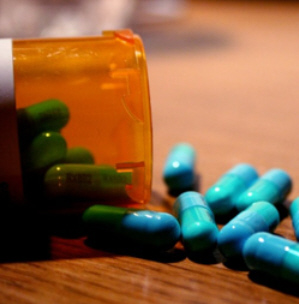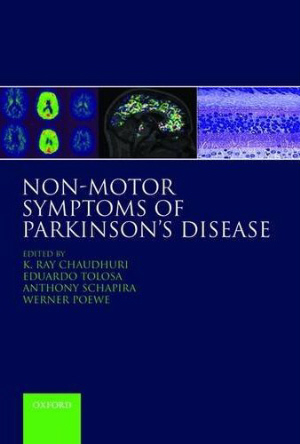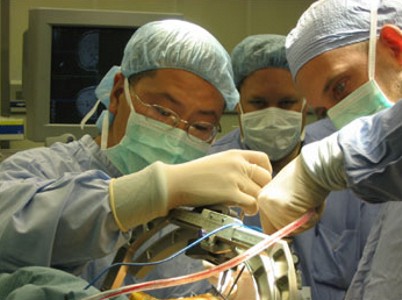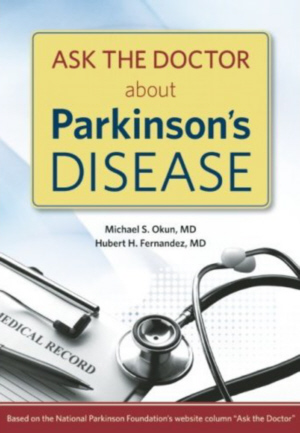|
AUGUST
2009
�����������������������������������������������������������������������������������������������������������������������������������������������������
25th August 2009 - New research
THE COMPARISON OF L-DOPA AND
DOPAMINE AGONISTS
American Family Physician [2009] 80 (1) : 28-30 (Hitzeman N, Rafii F.)
Complete abstract
Dopamine agonists have been found to have little advantage over the use of
L-dopa in the treatment of Parkinson's Disease. Dopamine agonists are being used
increasingly as the initial treatment for Parkinson Disease, but uncertainty remains about their
clinical-effectiveness and cost relative to the use of L-dopa.�
 Based on 29
clinical
trials involving over 5000 people, dyskinesia,
dystonia and motor fluctuations occurred less in people using dopamine agonists.
However, various non-motor adverse effects were worse in those using dopamine
agonists including : edema (fluid accumulation), somnolence (sleepiness),
dizziness, hallucinations, constipation, and nausea. Some agonists are also
known to cause compulsions. People treated with dopamine agonists were also
significantly more likely than people taking L-dopa to discontinue treatment
because of adverse events. The control of Parkinson's Disease symptoms was found
to be better with the use of L-dopa than with dopamine agonists.
In order to refer to this
article on its own
click here. Based on 29
clinical
trials involving over 5000 people, dyskinesia,
dystonia and motor fluctuations occurred less in people using dopamine agonists.
However, various non-motor adverse effects were worse in those using dopamine
agonists including : edema (fluid accumulation), somnolence (sleepiness),
dizziness, hallucinations, constipation, and nausea. Some agonists are also
known to cause compulsions. People treated with dopamine agonists were also
significantly more likely than people taking L-dopa to discontinue treatment
because of adverse events. The control of Parkinson's Disease symptoms was found
to be better with the use of L-dopa than with dopamine agonists.
In order to refer to this
article on its own
click here.
�
21st August 2009 - New book
THE NON-MOTOR SYMPTOMS COMPLEX OF PARKINSON'S DISEASE
K Ray Chaudhuri, Eduardo Tolosa,
Anthony Schapira, Werner Poewe
 Publisher's
description : Patients with Parkinson's disease are known to suffer from motor
symptoms, but they also experience non-motor symptoms that are often present
before diagnosis or that inevitably emerge with disease progression. Researchers
have only recently begun to focus on the non-motor symptoms, which are poorly
recognized and inadequately treated. The non-motor symptoms have a significant
impact on patient quality of life and mortality and include neuropsychiatric,
sleep-related, autonomic, gastrointestinal, and sensory symptoms. While some
non-motor symptoms can be improved with currently available treatments, others
may be more refractory and will require research into novel (non-dopaminergic)
drug therapies for the future. Edited by members of the UK Parkinson's Disease
Non-Motor Group (PD-NMG) and with contributions from international experts, this
book summarizes the current understanding of non-motor symptoms in Parkinson's
disease and points the way towards future research.
Click here for more details.� For more books concerning Parkinson's Disease go to
Parkinson's Disease Books. Publisher's
description : Patients with Parkinson's disease are known to suffer from motor
symptoms, but they also experience non-motor symptoms that are often present
before diagnosis or that inevitably emerge with disease progression. Researchers
have only recently begun to focus on the non-motor symptoms, which are poorly
recognized and inadequately treated. The non-motor symptoms have a significant
impact on patient quality of life and mortality and include neuropsychiatric,
sleep-related, autonomic, gastrointestinal, and sensory symptoms. While some
non-motor symptoms can be improved with currently available treatments, others
may be more refractory and will require research into novel (non-dopaminergic)
drug therapies for the future. Edited by members of the UK Parkinson's Disease
Non-Motor Group (PD-NMG) and with contributions from international experts, this
book summarizes the current understanding of non-motor symptoms in Parkinson's
disease and points the way towards future research.
Click here for more details.� For more books concerning Parkinson's Disease go to
Parkinson's Disease Books.
�
19th August 2009 - New research
THE LOSS OF SEX DRIVE IN
PARKINSON'S DISEASE
The journal of sexual
medicine [2009] 6 (4) : 1024-1031 (Kummer A, Cardoso F, Teixeira AL)
Complete abstract
 Sexual
dysfunction is a frequent but neglected problem in Parkinson's Disease, as
muscular problems are usually seen as the characteristic symptoms. However,
nearly two thirds (65.6%) of people with Parkinson's Disease have been found to
suffer a loss of sex drive. Over 42% of those men with Parkinson's Disease also
complained of erectile dysfunction. Ageing, female gender, lower education, and
depression were most associated with decreased sexual desire. Decreased interest
in sex was not associated with antidepressants. Neurological features that
were most associated with greater loss of sex drive were predominance of motor
symptoms on the left side of the body, autonomic dysfunction, and severer
Parkinson's Disease.
In order to refer to this
article on its own
click here. Sexual
dysfunction is a frequent but neglected problem in Parkinson's Disease, as
muscular problems are usually seen as the characteristic symptoms. However,
nearly two thirds (65.6%) of people with Parkinson's Disease have been found to
suffer a loss of sex drive. Over 42% of those men with Parkinson's Disease also
complained of erectile dysfunction. Ageing, female gender, lower education, and
depression were most associated with decreased sexual desire. Decreased interest
in sex was not associated with antidepressants. Neurological features that
were most associated with greater loss of sex drive were predominance of motor
symptoms on the left side of the body, autonomic dysfunction, and severer
Parkinson's Disease.
In order to refer to this
article on its own
click here.
�
16th August 2009 - New report
A FUTURE REPLACEMENT FOR SINEMET
According to a new
report, Depomed are developing a new drug called DM-1992 that could outperform Sinemet in the
treatment of Parkinson's Disease. For their report
click here.
The details are on page 20. Just like Sinemet, DM-1992 is a combination of
L-dopa and carbidopa, which prevents the breakdown of L-dopa.�
DM-1992 also includes AcuForm, which makes use of
the properties of certain
polymers. These polymers have long been used to "fluff" ice
cream and are safe to use. For more information go to
Depomed.
Upon entering the stomach an AcuForm coated pill expands and
is retained in the stomach for up to 8 hours. This helps to deliver a drug like
Sinemet over a longer period of time. Depomed's formulation was able to
extend the therapeutic duration of L-dopa to nine hours, compared to Sinemet CR's
seven hours. The time to reach peak blood levels was extended to four hours
compared to 2 hours for Sinemet CR. These advantages could enable a decrease in the dosage of L-dopa,
and the ridding of side effects such as nausea and dyskinesia.
In order to refer to this
article on its own
click here.
�
14th August 2009 - Web site
DBS SURGERY WEB SITE
 Deep
brain stimulation
(DBS) surgery is often used for Parkinson's Disease. It involves the use of electrodes that are implanted
into the brain and connected to a small electrical device. DBS can reduce the need for
L-dopa and related drugs, which in turn decreases the involuntary
movements called dyskinesias that are a common side effect of L-dopa.
DBS-STN.org
is a web site dealing with all aspects of DBS, which is probably the most
complex subject in Parkinson's Disease. For their web site go to
DBS-STN.org.�There
is also a
forum for DBS where people can raise issues
concerning it. Deep
brain stimulation
(DBS) surgery is often used for Parkinson's Disease. It involves the use of electrodes that are implanted
into the brain and connected to a small electrical device. DBS can reduce the need for
L-dopa and related drugs, which in turn decreases the involuntary
movements called dyskinesias that are a common side effect of L-dopa.
DBS-STN.org
is a web site dealing with all aspects of DBS, which is probably the most
complex subject in Parkinson's Disease. For their web site go to
DBS-STN.org.�There
is also a
forum for DBS where people can raise issues
concerning it.
�
11th August 2009 - New research
THE MICHAEL J.FOX FOUNDATION
FUNDS NINE NEW APPROACHES
 The
Michael J. Fox Foundation for Parkinson's Research is funding nine new research
projects for Parkinson's Disease. All of the nearly four million dollar funding
has gone to nine biotech and pharmaceutical
companies. For more
information read the
Press release.�The research projects consist of seven "neuroprotective approaches", and two
projects concerning the treatment of dyskinesia. The following provides links to
the details of each of the nine projects
: The
Michael J. Fox Foundation for Parkinson's Research is funding nine new research
projects for Parkinson's Disease. All of the nearly four million dollar funding
has gone to nine biotech and pharmaceutical
companies. For more
information read the
Press release.�The research projects consist of seven "neuroprotective approaches", and two
projects concerning the treatment of dyskinesia. The following provides links to
the details of each of the nine projects
:
|
* |
The pharmacodynamics
of ReS9-S7, which concerns early stage research in possible toxicity
[1].
The element being researched, alpha-synuclein, has never been shown to cause
Parkinson's Disease, but has instead been found only to be affected as a result of it. |
|
* |
Exploring curcumin
(which is found in a curry spice)� as a possible treatment of
Parkinson's Disease
[2]. Curcumin
is already widely used, due to its ready
availability, but has never rid Parkinson's Disease.
|
|
* |
The effect of novel
neuronal nicotinic receptor compounds on dyskinesia
[3].
Smoking has the same effect on the nicotinic receptors due its nicotine
contact, yet does not rid dyskinesia. |
|
* |
Assessment of the
therapeutic efficacy of progranulin in a sub-chronic animal model of
Parkinson�s disease
[4]. Other researchers have already shown
that progranulin has no potential in the treatment of� Parkinson's
Disease. |
|
* |
Validation of LRRK2 as
a drug target for treatment of Parkinson�s disease using antisense
technology
[5]. LRRK2 concerns only a genetic form of
Parkinson's Disease.
|
|
* |
Optimising lead series
of small molecule inhibitors of LRRK2 to deliver tool compounds and clinical
development candidates
[6]. LRRK2 concerns only a genetic form of
Parkinson's Disease.
|
|
* |
A novel approach to
characterize the distribution of a potentially therapeutic dominant-negative
inhibitor of TNF in pre-clinical models of PD, and predict the scalability
for an effective delivery of therapy in the human brain
[7]. This aims for drugs to be able to by
pass�the blood brain barrier. However, Parkinson's Disease has never
been shown to be due to a deficiency of the blood brain barrier.
|
|
* |
Pre-clinical
development of a Parkinson�s disease therapy using a glucagon-like peptide
(GLP-1) receptor agonist
[8]. It is already approved by the FDA, but
for diabetes rather than Parkinson's Disease.
|
|
* |
Optimization of MOR antagonists for the treatment of L-DOPA-induced
dyskinesias in Parkinson�s Disease
[9]. The theory behind its use does not,
even in theory, address the fact that dyskinesia is due to excessive L-dopa. |
|
In order to refer to this
article on its own
click here. |
�
8th August 2009 - New book
ASK THE DOCTOR ABOUT PARKINSON'S DISEASE
Michael S. Okun, Hubert H.
Fernandez
 Publisher's
description : Derived from Ask the Doctor, a website column written by the
authors for the National Parkinson Foundation, this book explores frequently
asked questions. It offers detailed answers to the most common questions,
including the role of heredity in Parkinson�s, its symptoms and diagnosis, the
effectiveness of drugs and other treatments, whether the disease�s progression
can be slowed, the future of stem cell treatment in the fight against
Parkinson�s disease, and many others. Written in plain, easy-to-understand
language, it arms readers with the knowledge they need to better understand and
manage the disease.
Click here for more details.� For more books concerning Parkinson's Disease go to
Parkinson's Disease Books. Publisher's
description : Derived from Ask the Doctor, a website column written by the
authors for the National Parkinson Foundation, this book explores frequently
asked questions. It offers detailed answers to the most common questions,
including the role of heredity in Parkinson�s, its symptoms and diagnosis, the
effectiveness of drugs and other treatments, whether the disease�s progression
can be slowed, the future of stem cell treatment in the fight against
Parkinson�s disease, and many others. Written in plain, easy-to-understand
language, it arms readers with the knowledge they need to better understand and
manage the disease.
Click here for more details.� For more books concerning Parkinson's Disease go to
Parkinson's Disease Books.
�
7th August 2009 - New research
WELL WATER AS A CAUSE OF PARKINSON'S DISEASE
Environmental Health
Perspectives [2009] (Nicole
M. Gatto, Myles Cockburn, Jeff Bronstein, Angelika D. Manthripragada, and Beate
Ritz)
Complete report
 Consumption
of pesticide contaminated well water has often been claimed to be a cause of
Parkinson�s Disease. When researchers investigated consumption of water from
private wells in areas with documented historical pesticide use, they found that
it was associated with an increased risk of Parkinson's Disease. Six pesticides
were examined : diazinon, chlorpyrifos, propargite, paraquat, dimethoate, and
methomyl. People with Parkinson's Disease were found to have consumed well water
an average of more than four years longer than people that did not have
Parkinson's Disease. Consumption of well water contaminated with the pesticides
methomyl, chlorpyrifos or propargite resulted in a 70% to 90% increase in the
risk of developing Parkinson's Disease. Exposure to a higher number of water
soluble pesticides and organophosphate pesticides also increased the risk of
causing Parkinson's Disease. For more information concerning toxic causes, go to
the
Toxic causes of Parkinson's Disease.
In order to refer to this
article on its own
click here. Consumption
of pesticide contaminated well water has often been claimed to be a cause of
Parkinson�s Disease. When researchers investigated consumption of water from
private wells in areas with documented historical pesticide use, they found that
it was associated with an increased risk of Parkinson's Disease. Six pesticides
were examined : diazinon, chlorpyrifos, propargite, paraquat, dimethoate, and
methomyl. People with Parkinson's Disease were found to have consumed well water
an average of more than four years longer than people that did not have
Parkinson's Disease. Consumption of well water contaminated with the pesticides
methomyl, chlorpyrifos or propargite resulted in a 70% to 90% increase in the
risk of developing Parkinson's Disease. Exposure to a higher number of water
soluble pesticides and organophosphate pesticides also increased the risk of
causing Parkinson's Disease. For more information concerning toxic causes, go to
the
Toxic causes of Parkinson's Disease.
In order to refer to this
article on its own
click here.
�
1st August 2009 - New research
THE WORLD'S HIGHEST PREVALENCE
OF PARKINSON'S DISEASE
Neuroepidemiology
[2009] 33 (3) : 225-230 (Racette BA, Good LM, Kissel AM, Criswell SR, Perlmutter
JS.)
Complete abstract
The world's highest prevalence of Parkinson's Disease by far has been found
among the Amish religious community, where Parkinson's Disease is two to three
times more prevalent than anywhere else in the world.
 The
Amish are primarily in the North East of the U.S.A. They are a devoutly
religious community who believe in the literal interpretation of the Bible. They
segregate themselves from other communities, wear traditional clothes, and live
a traditional lifestyle that does not permit the use of electricity, television,
radio, or telephones. For transport they use horses and carriages instead of
cars, which they are not allowed to use.
Most speak a German dialect known as Pennsylvania Dutch.
For more information click
here
and
here, and for a brief video of their lifestyle
click here. The
Amish are primarily in the North East of the U.S.A. They are a devoutly
religious community who believe in the literal interpretation of the Bible. They
segregate themselves from other communities, wear traditional clothes, and live
a traditional lifestyle that does not permit the use of electricity, television,
radio, or telephones. For transport they use horses and carriages instead of
cars, which they are not allowed to use.
Most speak a German dialect known as Pennsylvania Dutch.
For more information click
here
and
here, and for a brief video of their lifestyle
click here.
The prevalence of Parkinson's Disease
amongst the Amish aged 60 or older has been found to be 5,703 per 100,000, which
is enormously high. According to
U.N.Data, 17% of the U.S. population is aged
60 or older. So the prevalence�of Parkinson's Disease�in the Amish
community as a whole is� 970 per 100,000.�This is by far the highest
prevalence of Parkinson's Disease in the world, and around three times the
prevalence of the U.S.A., despite the U.S.A having the highest prevalence of any
country. For more information go to the
Prevalence of Parkinson's Disease. The Amish
refuse to take out health insurance. They are also afflicted by genetic
disorders. So it was thought that the cause might be genetic. However, the more
closely related they were, the less they were affected. They are primarily
involved in agriculture, and most of them use pesticides, but the effect of
pesticides was not assessed by the researchers.
In order to refer to this
article on its own
click here.
�
��
|
.gif)
.gif)
 Based on 29
clinical
trials involving over 5000 people, dyskinesia,
dystonia and motor fluctuations occurred less in people using dopamine agonists.
However, various non-motor adverse effects were worse in those using dopamine
agonists including : edema (fluid accumulation), somnolence (sleepiness),
dizziness, hallucinations, constipation, and nausea. Some agonists are also
known to cause compulsions. People treated with dopamine agonists were also
significantly more likely than people taking L-dopa to discontinue treatment
because of adverse events. The control of Parkinson's Disease symptoms was found
to be better with the use of L-dopa than with dopamine agonists.
In order to refer to this
article on its own
Based on 29
clinical
trials involving over 5000 people, dyskinesia,
dystonia and motor fluctuations occurred less in people using dopamine agonists.
However, various non-motor adverse effects were worse in those using dopamine
agonists including : edema (fluid accumulation), somnolence (sleepiness),
dizziness, hallucinations, constipation, and nausea. Some agonists are also
known to cause compulsions. People treated with dopamine agonists were also
significantly more likely than people taking L-dopa to discontinue treatment
because of adverse events. The control of Parkinson's Disease symptoms was found
to be better with the use of L-dopa than with dopamine agonists.
In order to refer to this
article on its own
 Publisher's
description : Patients with Parkinson's disease are known to suffer from motor
symptoms, but they also experience non-motor symptoms that are often present
before diagnosis or that inevitably emerge with disease progression. Researchers
have only recently begun to focus on the non-motor symptoms, which are poorly
recognized and inadequately treated. The non-motor symptoms have a significant
impact on patient quality of life and mortality and include neuropsychiatric,
sleep-related, autonomic, gastrointestinal, and sensory symptoms. While some
non-motor symptoms can be improved with currently available treatments, others
may be more refractory and will require research into novel (non-dopaminergic)
drug therapies for the future. Edited by members of the UK Parkinson's Disease
Non-Motor Group (PD-NMG) and with contributions from international experts, this
book summarizes the current understanding of non-motor symptoms in Parkinson's
disease and points the way towards future research.
Publisher's
description : Patients with Parkinson's disease are known to suffer from motor
symptoms, but they also experience non-motor symptoms that are often present
before diagnosis or that inevitably emerge with disease progression. Researchers
have only recently begun to focus on the non-motor symptoms, which are poorly
recognized and inadequately treated. The non-motor symptoms have a significant
impact on patient quality of life and mortality and include neuropsychiatric,
sleep-related, autonomic, gastrointestinal, and sensory symptoms. While some
non-motor symptoms can be improved with currently available treatments, others
may be more refractory and will require research into novel (non-dopaminergic)
drug therapies for the future. Edited by members of the UK Parkinson's Disease
Non-Motor Group (PD-NMG) and with contributions from international experts, this
book summarizes the current understanding of non-motor symptoms in Parkinson's
disease and points the way towards future research.
 Sexual
dysfunction is a frequent but neglected problem in Parkinson's Disease, as
muscular problems are usually seen as the characteristic symptoms. However,
nearly two thirds (65.6%) of people with Parkinson's Disease have been found to
suffer a loss of sex drive. Over 42% of those men with Parkinson's Disease also
complained of erectile dysfunction. Ageing, female gender, lower education, and
depression were most associated with decreased sexual desire. Decreased interest
in sex was not associated with antidepressants. Neurological features that
were most associated with greater loss of sex drive were predominance of motor
symptoms on the left side of the body, autonomic dysfunction, and severer
Parkinson's Disease.
In order to refer to this
article on its own
Sexual
dysfunction is a frequent but neglected problem in Parkinson's Disease, as
muscular problems are usually seen as the characteristic symptoms. However,
nearly two thirds (65.6%) of people with Parkinson's Disease have been found to
suffer a loss of sex drive. Over 42% of those men with Parkinson's Disease also
complained of erectile dysfunction. Ageing, female gender, lower education, and
depression were most associated with decreased sexual desire. Decreased interest
in sex was not associated with antidepressants. Neurological features that
were most associated with greater loss of sex drive were predominance of motor
symptoms on the left side of the body, autonomic dysfunction, and severer
Parkinson's Disease.
In order to refer to this
article on its own

 The
Michael J. Fox Foundation for Parkinson's Research is funding nine new research
projects for Parkinson's Disease. All of the nearly four million dollar funding
has gone to nine biotech and pharmaceutical
companies. For more
information read the
The
Michael J. Fox Foundation for Parkinson's Research is funding nine new research
projects for Parkinson's Disease. All of the nearly four million dollar funding
has gone to nine biotech and pharmaceutical
companies. For more
information read the
 Publisher's
description : Derived from Ask the Doctor, a website column written by the
authors for the National Parkinson Foundation, this book explores frequently
asked questions. It offers detailed answers to the most common questions,
including the role of heredity in Parkinson�s, its symptoms and diagnosis, the
effectiveness of drugs and other treatments, whether the disease�s progression
can be slowed, the future of stem cell treatment in the fight against
Parkinson�s disease, and many others. Written in plain, easy-to-understand
language, it arms readers with the knowledge they need to better understand and
manage the disease.
Publisher's
description : Derived from Ask the Doctor, a website column written by the
authors for the National Parkinson Foundation, this book explores frequently
asked questions. It offers detailed answers to the most common questions,
including the role of heredity in Parkinson�s, its symptoms and diagnosis, the
effectiveness of drugs and other treatments, whether the disease�s progression
can be slowed, the future of stem cell treatment in the fight against
Parkinson�s disease, and many others. Written in plain, easy-to-understand
language, it arms readers with the knowledge they need to better understand and
manage the disease.
 Consumption
of pesticide contaminated well water has often been claimed to be a cause of
Parkinson�s Disease. When researchers investigated consumption of water from
private wells in areas with documented historical pesticide use, they found that
it was associated with an increased risk of Parkinson's Disease. Six pesticides
were examined : diazinon, chlorpyrifos, propargite, paraquat, dimethoate, and
methomyl. People with Parkinson's Disease were found to have consumed well water
an average of more than four years longer than people that did not have
Parkinson's Disease. Consumption of well water contaminated with the pesticides
methomyl, chlorpyrifos or propargite resulted in a 70% to 90% increase in the
risk of developing Parkinson's Disease. Exposure to a higher number of water
soluble pesticides and organophosphate pesticides also increased the risk of
causing Parkinson's Disease. For more information concerning toxic causes, go to
the
Consumption
of pesticide contaminated well water has often been claimed to be a cause of
Parkinson�s Disease. When researchers investigated consumption of water from
private wells in areas with documented historical pesticide use, they found that
it was associated with an increased risk of Parkinson's Disease. Six pesticides
were examined : diazinon, chlorpyrifos, propargite, paraquat, dimethoate, and
methomyl. People with Parkinson's Disease were found to have consumed well water
an average of more than four years longer than people that did not have
Parkinson's Disease. Consumption of well water contaminated with the pesticides
methomyl, chlorpyrifos or propargite resulted in a 70% to 90% increase in the
risk of developing Parkinson's Disease. Exposure to a higher number of water
soluble pesticides and organophosphate pesticides also increased the risk of
causing Parkinson's Disease. For more information concerning toxic causes, go to
the
 The
Amish are primarily in the North East of the U.S.A. They are a devoutly
religious community who believe in the literal interpretation of the Bible. They
segregate themselves from other communities, wear traditional clothes, and live
a traditional lifestyle that does not permit the use of electricity, television,
radio, or telephones. For transport they use horses and carriages instead of
cars, which they are not allowed to use.
Most speak a German dialect known as Pennsylvania Dutch.
For more information click
The
Amish are primarily in the North East of the U.S.A. They are a devoutly
religious community who believe in the literal interpretation of the Bible. They
segregate themselves from other communities, wear traditional clothes, and live
a traditional lifestyle that does not permit the use of electricity, television,
radio, or telephones. For transport they use horses and carriages instead of
cars, which they are not allowed to use.
Most speak a German dialect known as Pennsylvania Dutch.
For more information click